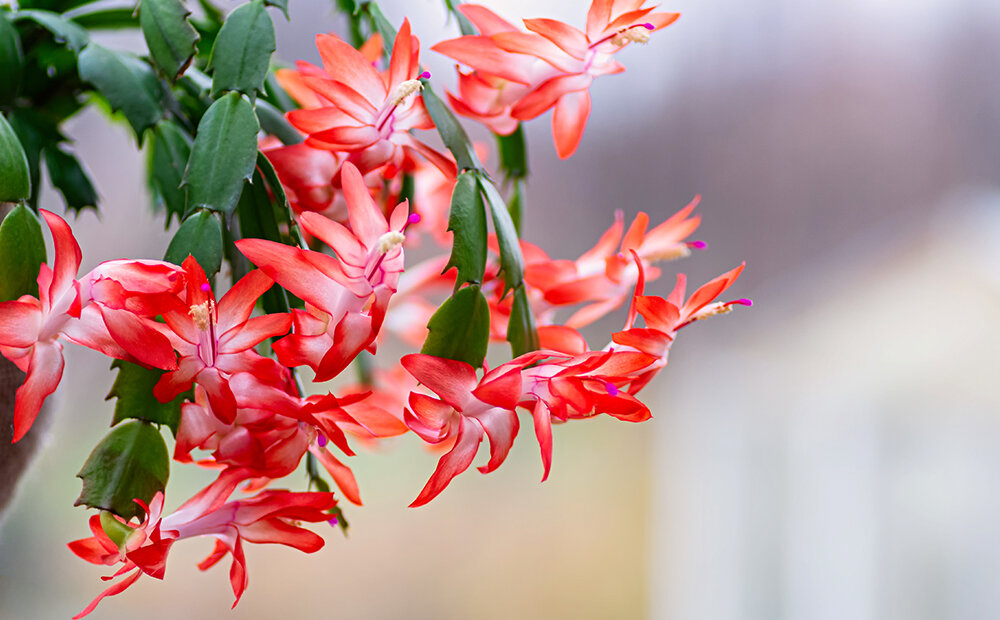The Christmas cactus, with its vibrant blooms and festive charm, is a beloved addition to many households during the holiday season. However, caring for this unique plant can be a bit tricky, requiring just the right balance of light, water, and temperature to thrive. In this comprehensive guide, we’ll explore everything you need to know to ensure your Christmas cactus dazzles with beautiful blooms year after year.
Understanding the Christmas Cactus:
Before delving into care tips, it’s essential to understand the Christmas cactus and its unique characteristics. Contrary to its name, the Christmas cactus (Schlumbergera bridgessii) is not a true cactus but rather a tropical plant native to the rainforests of Brazil. Unlike desert cacti, Christmas cacti are epiphytic, meaning they grow on trees or rocks rather than in soil. This distinction impacts their care requirements significantly.

Light Requirements:
Proper lighting is crucial for the health and blooming of your Christmas cactus. While these plants thrive in bright, indirect light, they should be shielded from direct sunlight, which can scorch their delicate leaves. Ideally, place your Christmas cactus near a window with sheer curtains or in a well-lit room away from intense sunlight.
During the growing season in spring and summer, ensure your plant receives adequate light to encourage healthy growth. However, as fall approaches and the days shorten, reduce exposure to light to stimulate blooming. Mimicking natural light cycles is key to triggering flower production in Christmas cacti.
Watering:
Finding the right watering routine is essential for Christmas cactus care. These plants prefer consistently moist but not waterlogged soil. Overwatering can lead to root rot, while underwatering can cause the plant to wilt and drop its buds.
During the active growing season in spring and summer, water your Christmas cactus thoroughly whenever the top inch of soil feels dry to the touch. Ensure proper drainage to prevent water from pooling at the bottom of the pot.
As fall arrives and the plant prepares to bloom, reduce watering frequency slightly to mimic its natural habitat’s drier conditions. However, maintain a level of moisture to prevent the plant from becoming parched.
Temperature and Humidity:
Maintaining the right temperature and humidity levels is essential for Christmas cactus care, especially during the blooming period. These plants thrive in temperatures between 60°F and 70°F (15°C to 21°C) during the day and slightly cooler temperatures at night.
Avoid exposing your Christmas cactus to drastic temperature fluctuations or drafts, which can stress the plant and inhibit blooming. Additionally, maintain moderate humidity levels around the plant, especially during the winter months when indoor air tends to be drier. Placing a humidifier nearby or placing the pot on a tray filled with pebbles and water can help increase humidity levels.
Fertilizing:
Regular fertilization is crucial for maintaining the health and vitality of your Christmas cactus. During the growing season from spring to early fall, fertilize your plant with a balanced, water-soluble fertilizer formulated for flowering houseplants. Dilute the fertilizer to half the recommended strength and apply it every two to four weeks.
However, once the plant enters its resting phase in late fall and winter, cease fertilization until the following spring when new growth resumes. Over-fertilizing can lead to salt buildup in the soil, causing root damage and hindering blooming.
Repotting:
While Christmas cacti prefer to be slightly pot-bound, they will benefit from repotting every two to three years to refresh the soil and provide additional space for root growth. Repot your plant in a slightly larger container using a well-draining potting mix formulated for cacti and succulents.
Choose a pot with drainage holes to prevent waterlogging, and carefully transfer the plant, being mindful not to damage its delicate roots. Repotting is best done in spring or early summer when the plant is actively growing and better equipped to recover from the transplant shock.
Propagation:
One of the joys of owning a Christmas cactus is the ability to propagate new plants from stem cuttings. Propagation is relatively easy and can be done at any time of the year, though spring and summer are ideal.
To propagate your Christmas cactus, simply take a healthy stem segment measuring 2-3 segments long and allow the cut end to callus over for a few days. Then, plant the cutting in a small pot filled with a well-draining potting mix and keep it lightly moist until roots develop. Once roots have formed, treat the new plant as you would a mature Christmas cactus.
Conclusion:
Mastering Christmas cactus care is a rewarding endeavor that yields stunning blooms and lush foliage throughout the holiday season and beyond. By providing the right balance of light, water, temperature, and care, you can ensure your Christmas cactus thrives year after year, bringing joy and beauty to your home. With the tips and techniques outlined in this guide, you’ll be well-equipped to enjoy the vibrant colors and festive cheer of this beloved holiday plant for generations to come.
Remember to visit christmascactuscare.com for more expert advice and resources on nurturing your Christmas cactus to its fullest potential. Happy gardening!



